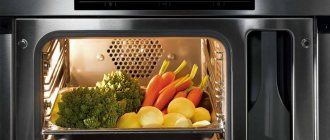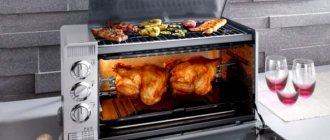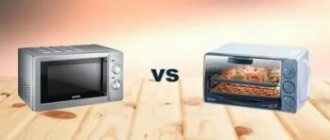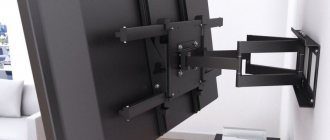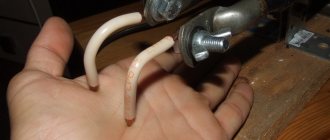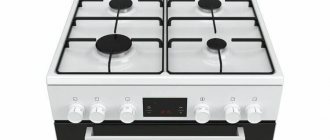A wall-mounted microwave bracket is a great opportunity to create an ergonomic design. But among all the diversity, it is very easy to make a mistake and make the wrong choice.
For ease of reading, the article is divided into several main parts:
- the first part talks about the features and types of brackets;
- the second contains the main indicators when choosing in a store;
- the third offers a master class on creating a structure yourself.
For ease of navigation, there is a list of all the items below - you can use them to go to any place in the article without rewinding.
Operating principle of the bracket
A bracket is a device that holds objects on the wall. It is distinguished from ordinary hinges by its complex, durable design, capable of extension and tilt. True, the simplest brackets can be built without such luxury.
Microwave brackets are often curved angles that are attached to the wall and connected together for added strength. Complex models are panels with fastening strips and other structures.
microwave bracket
The entire structure consists of different types of planks fixed to the wall. The principle of operation is to hold household appliances, in our case a microwave, in a place convenient for the owner.
What types of wall mounts are there for microwave ovens?
The whole variety of brackets comes in two main types - fixed and telescopic. The first is a static structure made of metal profiles and pipes that does not change its size.
The advantage of a fixed bracket is its strength: the absence of sliding units strengthens the connections. Often the fixed mount for a microwave on the wall is monolithic, which is good with maximum weight.
The telescopic one changes size, both vertically and horizontally. This fact allows you to adjust the dimensions within the permissible dimensions and load of the bracket. The solution allows us to obtain much less strength, which is definitely not good for the owner.
If you decide to buy a microwave for a long time, then it is more profitable to buy a fixed bracket without risking its strength and health. If you need to change your microwave in the near future, buy a telescopic one - preferably with universal fasteners.
What types of brackets are there for a microwave oven?
The main advantage of brackets for installing a microwave oven is that they are practically invisible when the device is installed on them. The downside is that the device may fly off in a side impact. If the chosen place is “impassable”, it’s not a big deal. Otherwise, it is better to choose a shelf with side edges or come up with some kind of stops for fixing the device.
One of the options is on brackets
When choosing a bracket for a microwave, pay attention to the weight they are designed for. It is also worth thinking about the load-bearing capacity of the wall on which you are going to hang the microwave. To distribute it evenly, you need to choose models in which the part of the bracket that is screwed to the wall is long. And holes for fasteners are distributed along the entire length.
Another good option is a horizontal jumper. It is mounted on the wall, and there are L-shaped supports for the microwave oven. This way the load is also distributed over a larger surface.
Microwave bracket for wall. Its “load capacity” should cover the weight of the stove
What else can you say about microwave oven brackets? They can be telescopic with the ability to adjust the length to which the stops extend. There may be plastic pads on the stops. Thanks to them, the device slips less. You can choose brackets by color. This is usually painted metal. More often they take it either in the color with the microwave oven, or in the color with the kitchen furniture.
Microwave bracket on the wall: what is it for, how to use it?
As already mentioned, the main purpose of the bracket is to secure the microwave to the wall. The bracket is also used as a shelf or a hanger for kitchen appliances: the possibilities completely depend on the model and installation location.
microwave bracket
Its only use is to mount it on the wall and install the microwave. An important point is that brackets for microwave ovens are calculated only by their weight. Using a bracket for such a purpose harms both the object placed on it and the people around it, increasing the risk of injury due to breakage.
Types of wall mounts for microwave ovens
Devices designed for wall-mounted installation of a microwave oven are of two types - brackets and a stand, which differ in their design, but are similar in the method of mounting on the wall.
Brackets for microwave oven
Brackets are two L-shaped holders, in which one shelf is attached to the wall surface, and the second serves as a base on which the equipment is installed. A shelf intended for installing a microwave oven may have a telescopic design, making it possible to adjust the length of this element to the size of the model of the household appliance. The shelf, designed for mounting to the wall, has holes for attaching the bracket. Microwave bracket model “Holder MWS-2002” The brackets are made of metal and can be made without painting, in the case of using stainless or other non-corrosion steel, and also painted with powder paint.
Microwave oven stand
A stand or, in other words, a shelf hung on the wall and intended for installing a microwave oven, can be of various shapes and designs, made in a factory or independently from scrap materials. The main element of such a product is a shelf, fixed to the wall surface using corners, brackets or other structural elements using fasteners, as in the case of using brackets.
The shelf can be made of metal or durable plastic, wood or glass, and the structural elements that provide fastening to the wall are made of metal. Option for installing a multifunctional wall-mounted stand made of metal
Choosing a location for installation
The installation location depends on the type of fastener. Fixed brackets are often installed flush against the rest of the furniture to create a unified space. Sliding ones require more or less space in the future, since the dimensions can change.
The task comes down to creating an additional surface. This parameter helps to place the microwave in a good place and create an ergonomic, interesting interior.
A great place to place a fixed bracket is next to a kitchen drawer. An option is possible when installing a bracket under a separate drawer where there is no table top.
The telescopic one serves well as a continuation of the kitchen set to the right and left of it. Using the space will allow you to change the size of the bracket in the future without spoiling the appearance of the kitchen.
Choosing a location to install the microwave oven bracket
When choosing a location for installing a bracket for a microwave oven, follow two important rules:
- do not place the mount on a walkway or in places where people are often present;
- Do not place the mount too high or low.
In the first case, the bracket with the microwave restricts access to the room, making passage inconvenient. This leads to injuries and breakage of fasteners, followed by the fall of the stove.
Example of a wall bracket with a maximum load of up to 40 kg.
When installing the stove next to a passage, maintain a distance of 300 mm from doors and corners - this will make it difficult to accidentally touch it and drop it.
In the second case, remember the average height of a person is 1.7 meters. It is inconvenient for people with short stature to place and take out hot soup from a two-meter height. When choosing a height, consider the height of the shortest family member.
Do not mount low - it does not look aesthetically pleasing and is inconvenient. If the bracket is placed too low, small children gain access to the microwave, and this is extremely dangerous for themselves and those around them.
The optimal height is the zone from 1200 to 1500mm, perfect for any person.
Mounting device on a horizontal bar.
When choosing the location of the fasteners, pay attention to style compatibility - the more laconic and organic the stove looks, the better. A great method is to place the mount under cabinets in a “dead zone” that is not typically used while working in the kitchen.
How to choose a microwave bracket
The main qualities of the bracket include:
- maximum weight supported by the structure;
- dimensions;
- material;
- brand and price.
The characteristics of the microwave serve as guidelines. Based on its weight and size, the characteristics of the bracket are selected.
microwave bracket
Maximum permissible weight
The maximum permissible weight is based on the design of the bracket (bends, additional supports). The material of the product is also important. The maximum weight of fixed models is greater than telescopic ones, which is explained by the smaller number of vulnerable nodes in the circuit.
Look for the weight indicator on the bracket packaging. The number is theoretical and certified - the bracket will definitely not break under the specified weight. The mass above behaves unpredictably, even to the point of breakdown.
Choose the weight based on the weight of the microwave. In order not to be mistaken with the strength, take the weight of the microwave and add 3-5 kilograms to it, which will give you a margin of strength and allow you not to worry about the kitchen appliance.
Dimensions
The fixed size corresponds to the size of the microwave oven. Otherwise, the microwave will stick out from the platform and may even fall due to careless movement. It is advisable to calculate the dimensions of the microwave when installing it so that it does not stand out too much from the overall interior of the room.
Take telescopic ones of the largest possible size so that they are no smaller than the size of the microwave. Telescopic brackets are purchased with a reserve for the future, so as not to replace the fasteners when purchasing a new stove.
Material of manufacture
Among the materials, various metals are most often used. There is no particular difference between them - the whole difference depends on the weight of the finished structure and the softness of the material used. The softer it is, the more complex the structure will have to be created; if it is tougher, the simpler it will be.
Eliminate all options where powder steel is used - it crumbles very quickly and breaks easily. Therefore, you cannot trust brackets with plastic casings: powdered iron is often hidden in them.
There are also wooden options, most often from chipboard, laminated chipboard, and less often from solid wood. They are made in the form of a shelf and are often sold together with kitchen sets. In this case, you should choose solid wood - it is much stronger than chipboard.
Brand and cost
The cost directly depends on the brand. Often, kitchen appliance manufacturers offer their own brands of brackets and produce them independently. Quality varies everywhere, but the more popular the brand, the higher its cost.
Branding here is similar to usual: there are expensive brands and cheap ones. But often the difference between them is very small. When purchasing, do not turn to “famous” brackets from Spain.
Therefore, pay more attention to the quality of the material and the indicators on the packaging and the company name. This advice will protect you from sudden troubles, such as a crack in the powdered metal in a plastic casing.
The cost ranges from 500 rubles to 4 thousand for fixed models and from 1000 to 5000-6000 for telescopic ones. The cost is greatly influenced by the presence of additional features - hangers and additional shelves.
DIY microwave bracket on the wall
This part of the article is devoted to how to make a microwave bracket for the wall with your own hands. You will need:
- Laminated chipboard, other similar material;
- jigsaw;
- plate.
| The work begins with preparation. In the instructions, a layout of the future design was made in advance in the PRO100 program. | |
| Afterwards, cutting begins. The easiest way to do this is with a jigsaw. The edges are rounded by marking the corner with a plate, giving a suitable shape. | |
| Using the resulting markings, a corner is cut out with a jigsaw. | |
| Sand the corners with sandpaper. Next comes the preparation of the bars, they will serve as a support angle. | |
| A similar radius is made on the block using a plate in order to subsequently saw it. | |
| After preparation, begin assembling the structure. This is done using hexagon anchor screws. Drill holes in the side where the screws will be screwed in. Insert the screws and screw the self-tapping screws into them using a hex key. It is important here that the screws fit into the end that is not covered with laminate. | |
| The corner fasteners are also screwed on. | |
| Corner fasteners must be secured on both sides. Next is cutting out the screed. This will bring the two corner support bars together. | |
| First mark it according to the size obtained from the distance between the corner strips. Subsequently, the plank is sawn and inserted. Afterwards, all ends can be covered with trimming tape to improve the appearance of the product. Attaches both to dowels and to other types of fasteners to the wall. |
Video
The video below shows the entire process of creating a shelf-bracket for a microwave. From it you can find out more details and details.
Making a microwave stand with your own hands
It’s quite easy to make a microwave stand with your own hands. To do this, you will need a small furniture board and a metal corner 4 cm wide. You should measure the dimensions of the stove: depth, height and length. Next, add 5 cm on each side in length and 10 cm on one side in depth to allow air access to the back wall of the oven.
Then you should cut the corner into two parts, taking into account that the height of the bracket should be slightly less than the height of the microwave. In the middle of each corner you need to cut a 90 degree angle with a grinder. Having bent the profile at an angle of 90 degrees, weld the joints. Next, you need to drill holes in the corners for the stand and for mounting to the wall.
All that remains is to connect the bracket to the stand and then attach it to the wall. Now you can hang up the microwave oven. Anyone can make a bracket with their own hands.
Did you manage to solve your problem using the recommendations from the article?
Yes!
51.85%
No. More answers required. I'll ask in the comments now.
29.63%
Partially. There are still questions. I'll write in the comments now.
18.52%
Voted: 27
How the microwave is attached to the bracket
The mounting depends on the type of microwave. Most fixed brackets simply place the stove on top. Depending on the legs, it is installed either directly on them or past them. Sometimes the type of design involves installation with the legs fixed in special grooves.
Telescopic ones have a more complex fastening, with installation through pins that secure the microwave oven. The option is more convenient and reliable - the telescopic bracket can be adjusted, but a fixed one will have to be purchased according to the size.
